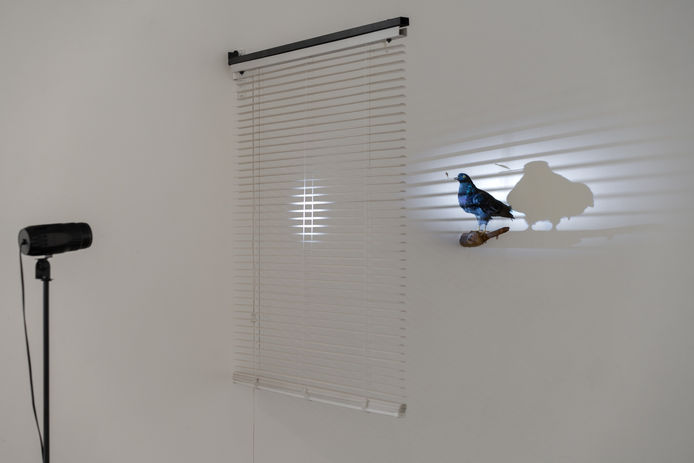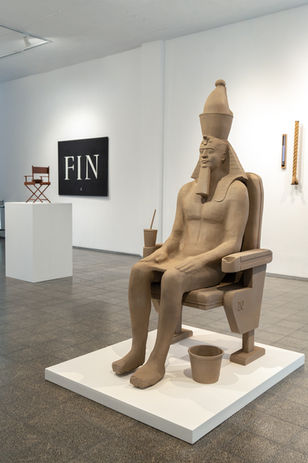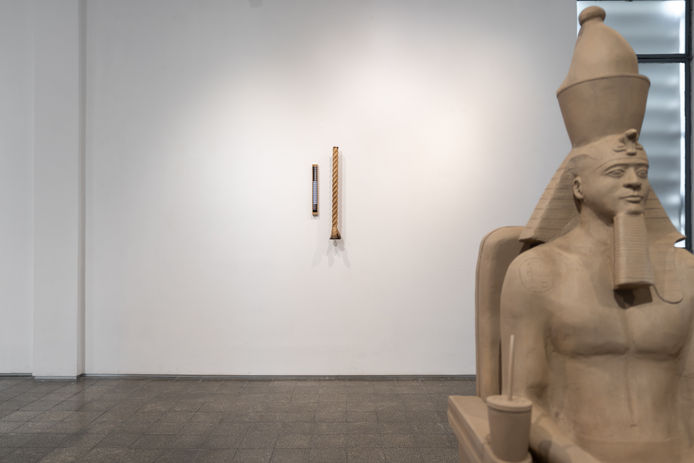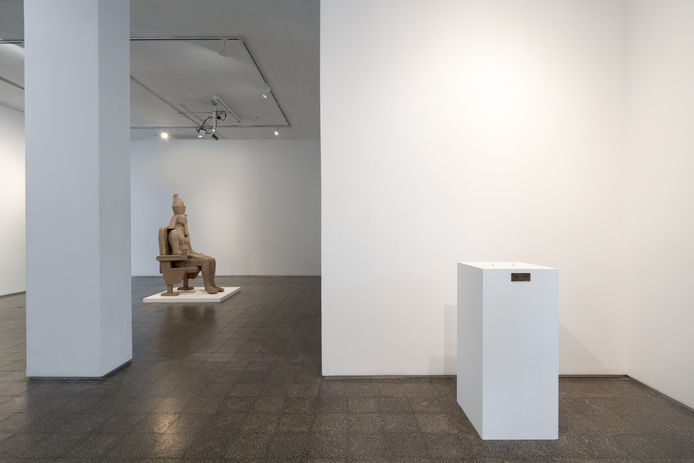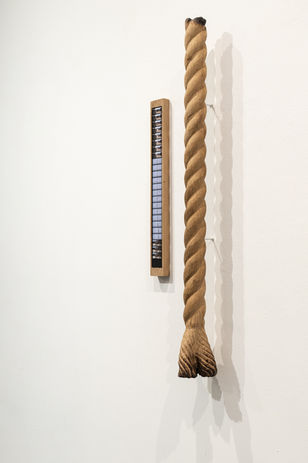Live End
Artist:
1.5.23

Live End
Curatorial accompaniment: Yael Azoulay
Download catalog
סוף חי | עמרי הרמלין
ליווי אוצרותי: יעל אזולאי
עבודתו של עומרי הרמלין משלבת בין נרטיבים מוכרים לבין אלמנטים של תרבות חזותית פופולארית, תקשורת המונים ופוליטיקה. הוא משלב דימויים וחומרים השואבים השראה מתרבות גבוהה ופופולארית כאחד ומייצר מערך של ציטוטים ואזכורים מרומזים, כדי לבחון את הקלישאות לצד האיכויות האמביוולנטיות המגולמות במיתוסים מודרניים.
בתערוכה סוף חי בוחר הרמלין לעסוק ב-סוף. סוף המוליד תחייה מחדש, סוף הסרט, מוות וסוף מיוחל. העבודות בתערוכה נוגעות בדרך זו או אחרת בסיומות, בעיקר מעולם הקולנוע. דרך הסרטים והז'אנרים הרמלין מביא משמעויות עמוקות נוספות - אישיות, תרבותיות ופוליטיות.
בעבודה עשר מציב הרמלין את דמותו של רעמסס יושב על כסא קולנוע ומביט בסרט עשרת הדיברות (סיסיל בי דמיל). הקול מושתק, ורעמסס מקבל את הבמה. המצביא הנרקיסיסט שדאג להותיר אחריו כמות מכובדת של פסלים מביט בעצמו בהאדרה כפולה. סיפור חוצה דורות שסופו ידוע, על מצביא שלא הקשיב, נע במעגלים בין דמותו בסרט לבין דמותו המפוסלת בכיסא הקולנוע, מזכיר לנו שתרבות המלכים עוד לא חלפה מהעולם.
בעבודה פיז'ון פאטאל, הרמלין מצליב בין המאפיינים של סרטי הפילם נואר לבין יונה עם עלה זית. כותרת העבודה יחד עם התריס הונציאני והתאורה הדרמטית, מציעים פרשנות חדשה לאותו סמל מוכר. במקום גאולה אולי סימן לגורל מר.
העבודה שניה אחת היא פירוק של שניה קולנועית, המורכבת מ-24 פריימים, לצד חבל מפוסל מעץ. השנייה לקוחה מהסרט הטוב הרע והמכוער (סרג'יו ליאונה), בה הטוב יורה בחבל הכרוך סביב צווארו של המכוער וחושף את שיתוף הפעולה של השניים. רגע שנדמה שהולך להיות סוף, מתגלה כאחר. החלוקה לפריימים חושפת את מה שאי אפשר לראות כאשר הסרט נע - החבל חתוך ומודבק מחדש. למרות האשליה שנחשפת, הקסם לא נעלם והחבל המפוסל רק מחזק אותו.
הסוף במערך העבודות שבתערוכה הוא סוף שיש בו אוויר. הרגעים ממשיכים לחיות באמצעות הצופים. דרך מפגשים בין מציאות לבדיה הרמלין פורם ותופר מחדש רגעים מהותיים בהיסטוריה התרבותית, אבל הבדיה מורכבת מאנשים בשר ודם, וגם המציאות כאן היא פסל.
Omri Harmelin | Live End
Curatorial accompaniment: Yael Azoulay
Omri Harmelin's work addresses familiar narratives with elements of popular visual culture, mass media and politics. He combines images and materials that draw inspiration from both high and popular culture and produces an array of quotations and implicit references, to examine the clichés alongside the ambivalent qualities embodied in modern myths.
In Live End exhibition, Harmelin chooses to deal with the end. The end that gives rise to rebirth, the end of the film, death and a long-awaited end. The works in the exhibition touch in one way or another on endings, mainly from the world of cinema. Through the films and genres Harmelin brings additional deep meanings - personal, cultural and political.
In the work ten Harmelin places the figure of Ramses II sitting on a movie theatre chair to watch the film The Ten Commandments (Cecil B. DeMille). The voice is silenced, and Ramses II takes the stage. The narcissistic commander who made sure to leave behind a respectable amount of statues looks at himself with double glory. A cross-generational story whose end is known, about a ruler who did not listen, moving in circles between his image in the film and his sculpted image in the movie theatre chair, reminds us that the culture of kings has not yet passed away from the world.
In the work Pigeon Fatal, Harmelin crosses the characteristics of film noir films with a dove with an olive leaf. The title of the work together with the venetian blinds and the dramatic lighting, offer a new interpretation of the same familiar symbol. Instead of redemption maybe a sign of a bitter fate.
The work One Second is a breakdown of a cinematic second, consisting of 24 frames, next to a sculpted wooden rope. The second is taken from the film The Good, the Bad and the Ugly (Sergio Leone), in which the good shoots the rope around the neck of the ugly and reveals the cooperation of the two. A moment that seems to be ending, turns out to be another. The division into frames reveals what cannot be seen when the film is moving - the rope is cut and re-glued. Despite the illusion that is revealed, the magic does not disappear and the sculpted rope only strengthens it.
The end in these set of works in the exhibition is an end that has air. The moments live on through the viewers. Through encounters between reality and fiction Harmelin reshapes and re-stitches essential moments in cultural history, but fiction consists of flesh and blood, and reality here is also a sculpture.


